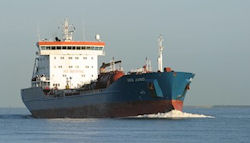Features
Pathways towards low carbon shipping
Date: 2013-01-22 15:05:23.0
Author: DNV Research & Innovation
 Høvik, Norway -- Possible pathways to reduce CO2 emissions from shipping are just published in a new position paper from DNV Research and Innovation, giving directions for more environmentally friendly seaborne trade.
Høvik, Norway -- Possible pathways to reduce CO2 emissions from shipping are just published in a new position paper from DNV Research and Innovation, giving directions for more environmentally friendly seaborne trade.
The shipping sector is quickly becoming responsible for an increased part of the world’s carbon dioxide emissions, due to its heavy dependency on fossil fuels combined with growth in international seaborne trade. CO2 emissions from ships could count for at least 10 % of global emissions in 2050, as compared to 3 % today, if measures are not taken. With rising fuel prices and impending environmental regulations, the pressure is on for more efficient and environmentally friendly ships.
DNVs pathways study shows a doubling of present CO2 emissions by 2050 if we do nothing. It further shows that uptake of operational and technical measures combined with biofuels and LNG give a cost effective CO2 reduction potential of 50% in 2050. However, if CO2 emissions from shipping are halved by 2050, the relative share of global emissions contributed by shipping would still be double of what it is today, since other industries improve. Hence, more must be done to stay at par.
“If shipping should be required to reach emission levels in 2050 consistent with a global 2oC stabilization target, we need to do more than stabilizing emissions at present level. To achieve the 2oC target, the shipping sector must reduce CO2 emissions by 60 % from today’s emission level”, says Magnus Strandmyr Eide, Senior Researcher at DNV Research & Innovation and main author of DNVs pathways study.
The study has identified two plausible pathways for the 2oC target for shipping; either allowing for nuclear power, or by providing financial incentives for biofuel. It is realized that other pathways are possible, e.g. by including technologies currently very costly or immature, or through technological breakthroughs which are not identified, but which should be expected. From the existing alternatives, the introduction and use of biofuels stands out as the best option, considering the overall environmental, safety and security impacts.
Widespread use of biofuel in shipping depends on price, incentives and availability in sufficient volume. To capitalize on the potential, action must be taken by ship-owners, technology developers and regulators. This includes development of full scale on board prototyping and testing, as well as infrastructure development for bunkering.
DNV Research & Innovation
DNV Research & Innovation is investigating a number of alternative fuels available today, or expected to be available in the near future. We focus on gathering state-of-the-art data regarding different fuel pathways from a life cycle perspective. With respect to greenhouse gas emissions, the way a fuel is produced and transported (Well-To-Tank part of the fuel cycle) contributes approximately 10- 20% to its overall greenhouse gas emissions (Well-to-Propeller). For biofuels the Well-To-Tank part corresponds to 100% of its GHG emissions.
There are many potential alternative fuels to oil-based marine fuels, and each one is characterized by advantages in certain areas (such as availability, safety, pollutant emissions, greenhouse gas emissions, cost, etc.), compared with its counterparts.
Currently, the most promising alternative fuel for shipping is LNG, due to large volumes available, SOx and NOx emissions benefits, price competitiveness to oil-based fuels, and the relative maturity of infrastructure and engine technology. However, all available candidate fuels for the future should be further investigated, since they can play an increasingly significant role in the long term.
DNV invests 6% of its revenue in research and development activities. 1% of the revenue is dedicated to strategic research with a long-term focus. A key aspect of the strategic research is to identify main technology and risk management trends. Another is to develop new competences and services for the future.
Knowledge sharing is core to our success. A position Paper from DNV Research and Innovation is intended to highlight findings from our research programs. While some of these projects find solutions to specific technological challenges, others aim to share best engineering practices or to develop new global standards.
For more information about DNV Research & Innovation please visit their website here
Displaying 3 keywords used to tag this article:
- enzymes
- patents
- carbon capture
